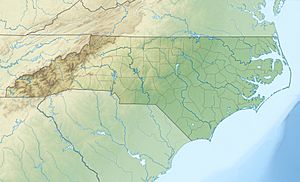Little Buffalo Creek (Deep River tributary) facts for kids
Quick facts for kids Little Buffalo Creek |
|
|---|---|
|
Location of Little Buffalo Creek mouth
|
|
| Other name(s) | Tributary to Deep River |
| Country | United States |
| State | North Carolina |
| County | Lee |
| City | Sanford |
| Physical characteristics | |
| Main source | divide of Gasters Creek Sanford, North Carolina 400 ft (120 m) 35°27′43″N 079°09′12″W / 35.46194°N 79.15333°W |
| River mouth | Deep River about 2 miles east-northeast of Farmville, North Carolina 198 ft (60 m) 35°34′44″N 079°11′21″W / 35.57889°N 79.18917°W |
| Length | 9.33 mi (15.02 km) |
| Basin features | |
| Progression | generally north |
| River system | Deep River |
| Basin size | 8.20 square miles (21.2 km2) |
| Tributaries |
|
| Waterbodies | unnamed reservoir |
| Bridges | US 421, E Rose Street, S 3rd Street, Hickory Avenue, Maple Avenue, McIver Street, Charlotte Avenue, E Chisholm Street, E Weatherspoon Street, NC 87, Amos Bridges Road, US 1, Oak Park Road, Deep River Road |
Little Buffalo Creek is a cool stream located in Lee County, North Carolina. It stretches for about 9.33 miles (15.02 kilometers). This creek is a "tributary," which means it's a smaller stream that flows into a larger river. Little Buffalo Creek flows into the Deep River.
Contents
The Journey of Little Buffalo Creek
Little Buffalo Creek begins its journey in the town of Sanford, North Carolina. From there, it flows generally north.
Where the Creek Ends
After its journey, Little Buffalo Creek joins the Deep River. This meeting point is about 2 miles (3.2 kilometers) east-northeast of a place called Farmville, North Carolina.
Understanding the Creek's Environment
Every river and stream has an area of land that drains water into it. This area is called a "watershed." Little Buffalo Creek's watershed covers about 8.20 square miles (21.2 square kilometers).
Water and Land in the Watershed
The watershed receives a good amount of rain each year, about 47.6 inches (121 centimeters). A large part of this area, about 35%, is covered by forests. Forests are very important because they help keep the water clean and provide homes for wildlife.



